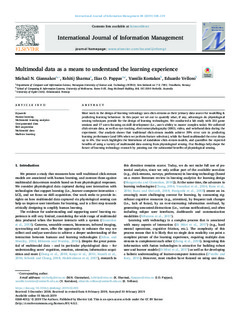| dc.contributor.author | Giannakos, Michail | |
| dc.contributor.author | Sharma, Kshitij | |
| dc.contributor.author | Pappas, Ilias | |
| dc.contributor.author | Kostakos, Vassilis | |
| dc.contributor.author | Velloso, Eduardo | |
| dc.date.accessioned | 2020-01-03T13:39:45Z | |
| dc.date.available | 2020-01-03T13:39:45Z | |
| dc.date.created | 2019-03-15T16:39:40Z | |
| dc.date.issued | 2019 | |
| dc.identifier.citation | International Journal of Information Management. 2019, 48 108-119. | nb_NO |
| dc.identifier.issn | 0268-4012 | |
| dc.identifier.uri | http://hdl.handle.net/11250/2634843 | |
| dc.description.abstract | Most work in the design of learning technology uses click-streams as their primary data source for modelling & predicting learning behaviour. In this paper we set out to quantify what, if any, advantages do physiological sensing techniques provide for the design of learning technologies. We conducted a lab study with 251 game sessions and 17 users focusing on skill development (i.e., user's ability to master complex tasks). We collected click-stream data, as well as eye-tracking, electroencephalography (EEG), video, and wristband data during the experiment. Our analysis shows that traditional click-stream models achieve 39% error rate in predicting learning performance (and 18% when we perform feature selection), while for fused multimodal the error drops up to 6%. Our work highlights the limitations of standalone click-stream models, and quantifies the expected benefits of using a variety of multimodal data coming from physiological sensing. Our findings help shape the future of learning technology research by pointing out the substantial benefits of physiological sensing. | nb_NO |
| dc.language.iso | eng | nb_NO |
| dc.publisher | Elsevier | nb_NO |
| dc.rights | Navngivelse 4.0 Internasjonal | * |
| dc.rights.uri | http://creativecommons.org/licenses/by/4.0/deed.no | * |
| dc.title | Multimodal data as a means to understand the learning experience | nb_NO |
| dc.type | Journal article | nb_NO |
| dc.type | Peer reviewed | nb_NO |
| dc.description.version | publishedVersion | nb_NO |
| dc.source.pagenumber | 108-119 | nb_NO |
| dc.source.volume | 48 | nb_NO |
| dc.source.journal | International Journal of Information Management | nb_NO |
| dc.identifier.doi | 10.1016/j.ijinfomgt.2019.02.003 | |
| dc.identifier.cristin | 1685215 | |
| dc.relation.project | Norges forskningsråd: 255129 | nb_NO |
| dc.relation.project | Norges forskningsråd: 290994 | nb_NO |
| dc.description.localcode | © 2019 The Authors. Published by Elsevier Ltd. This is an open access article under the CC BY license (http://creativecommons.org/licenses/BY/4.0/). | nb_NO |
| cristin.unitcode | 194,63,10,0 | |
| cristin.unitname | Institutt for datateknologi og informatikk | |
| cristin.ispublished | true | |
| cristin.fulltext | preprint | |
| cristin.fulltext | original | |
| cristin.qualitycode | 2 | |

